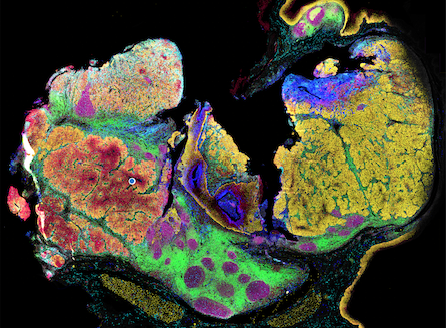The discovery of cancer biomarkers is a critical component to improving patient outcomes. Key biomarkers not only determine what drives tumor growth, they also facilitate the development of treatment strategies that specifically target the tumor. However, biomarker discovery requires deep tissue characterization. Currently, cancer biomarkers are typically limited in their ability to capture tumor microenvironment (TME) features.
To date, no validated biomarkers have been identified to predict immunotherapy responsiveness across head and neck squamous cell carcinomas (HNSCC) patients. Now, researchers from Akoya Biosciences and the University of Queensland, Brisbane, Australia, have optimized and applied an ultra-high plex, single-cell spatial protein analysis in HNSCCs. Tissues were analyzed with a panel of 101 antibodies that targeted biomarkers related to tumor immune, metabolic, and stress microenvironments.
“This work brought together the latest advances in spatial biology and paired these with ultra-high plex antibody panels and profiled real-world patient samples,” noted Arutha Kulasinghe, PhD, senior research fellow, Frazer Institute, University of Queensland, Australia, where he also leads the Clinical-oMx Lab.
This work is published in GEN Biotechnology in the paper, “Mapping the Spatial Proteome of Head and Neck Tumors: Key Immune Mediators and Metabolic Determinants in the Tumor Microenvironment.”
HNSCCs are tumors that develop in the lip, oral cavity, larynx, salivary glands, nose, sinuses, or the skin of the face. They are the seventh most common cancer globally causing more than 300,000 deaths annually. Immune checkpoint inhibitors have shown promise in treating recurrent/metastatic cases.
Here, researchers present a framework for single-cell spatial analysis of proteins to analyze HNSCCs. First, they developed an ultra-high plex antibody panel with antibodies for detection of immune cells, cancer cells, and markers that identify cellular metabolism, apoptosis and stress, tumor invasion, and metastasis, as well as cellular proliferation and deregulation.
“It’s a significant step forward,” noted Kulasinghe. “Usually, we profile 10–20 markers on tissue routinely. This study developed and tested 101 markers focused on the hallmarks of cancer pathways. It’s a technological breakthrough and now lends itself for high throughput applications such as clinical studies.”
The data uncovered a “high degree of intra-tumoral heterogeneity intrinsic to HNSCC” and provided unique insights into the biology underlying the disease.
This study showed, explained Kulasinghe, that tumors are highly heterogeneous and have areas akin to “north” and “south” poles for treatment sensitivity. “Understanding this and visualizing this is very powerful for the field of immunotherapy and precision medicine,” he asserted.
Single-cell spatial phenotyping of the human FFPE head and neck squamous cell carcinoma revealed six spatial neighborhoods across 14 distinct cell types. In addition, functional phenotyping based on key metabolic and stress markers identified four distinct tumor regions with high intra-tumoral heterogeneity and differential protein signatures.
More specifically, the authors noted that one region was marked by infiltration of CD8+ cytotoxic T cells and overexpression of a proapoptotic regulator—suggesting strong immune activation and stress. Another adjacent region within the same tumor had high levels of expression of G6PD and MMP9. These proteins are known to drive the processes of tumor resistance and invasion, respectively.
The research provides a more complete understanding of the tumor immune microenvironment. It also provides insights into the metabolic state and biology of different regions within the tumor. The data describe an interplay between immune infiltration and the metabolic and stress responses of tumor cells in certain areas. In addition, the findings demonstrate that heterogenous niches and competing microenvironments may underpin variable clinical responses.
Lastly, noted Kulasinghe, “The study sets the framework and workflow for true highplex discovery studies for clinical applications.”



